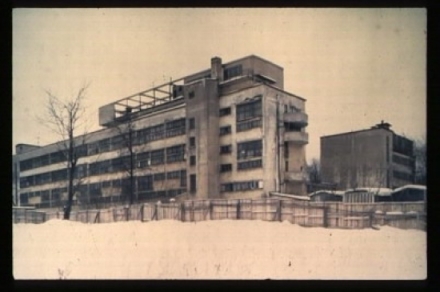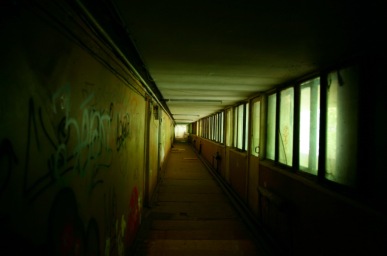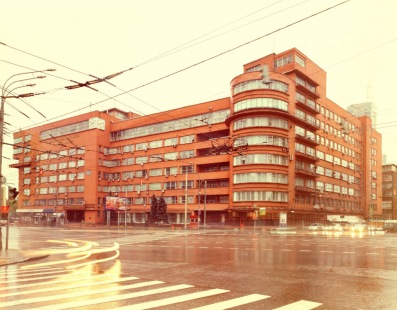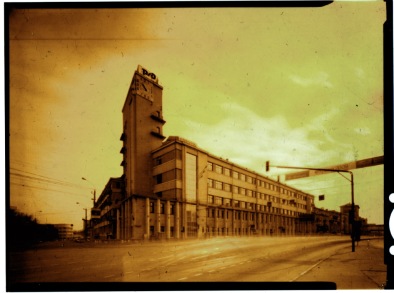Moisei Ginzburg & Ignatii Milinis’
iconic constructivist masterpiece
.
Over the last couple years I’ve amassed a frightening number of high-quality photographs and image scans depicting Moisei Ginzburg and Ignatii Milinis’ Dom Narkomfin in Moscow. It is, without question, one of the most iconic pieces of Soviet constructivist architecture that was actually realized.
For this very reason, however, it has already been the subject of countless studies and historical investigations. Some of these have been quite good: Owen Hatherley’s Catherine Cooke’s. Others have been competent, if unmoving: Victor Buchli’s. George Baird’s treatment of Narkomfin in The Space of Appearance left me singularly unimpressed — something I wasn’t counting on, since I generally appreciate his architectural criticism.
Regardless, there’s very little new to say about the building, at least in English or in Russian. While I debated for some time whether or not I should write something “original” on Narkomfin, offering my own “unique” perspective, I’ve finally decided that my energies would be best spent elsewhere. Hence, I am appending just a few short overviews of the structure, detailing its layout and specifications, as well as Owen Hatherley’s longer description of the building from Militant Modernism (2009).
A few months ago, I did something similar with his article “Buried Treasure.” Maybe I’ll translate a short bit on Narkomfin from Sovremennaia arkhitektura soon. Enjoy this for now, however!

Building the main section of Narkomfin

View of Narkomfin’s western facade during construction, 1929

View of Narkomfin’s western facade during construction, 1929

Moisei Ginzburg surveys the site with construction workers, 1929

Workers building Narkomfin, 1929

Narkomfin’s penthouse under construction
Specifications
.
Moisei Ginzburg and Ignatii Milinis (1929).
A collective house for workers in the
People’s Commissariat of Finance.
Moscow, USSR. Novinskii Boulevard.
The shorter wing of the complex houses a children’s home, dining room, kitchen, and laundry. The complex is placed in the center of a park, away from street noise. Apartments are two stories high. Height of rooms is 2.2 m, that is, for two-story spaces, 4.4 m. Continuous side corridor every second floor. Roof garden. On the ground floor are rooms for rest and recreation.
The individual bourgeois apartment is no longer appropriate for new dwelling relations, which are based on principles other than the unified patriarchal family with its petty individualistic conduct. The economic routines of the worker’s family (nutrition, cleaning, washing) as well as the education of children, their care and control and the fulfillment of the cultural and sport needs of workers and children, can and must be collectivized, that is, produced on a collective basis. Therefore all those rooms that for their functional destination and their character must serve entire collectives and not only single individuals must be reshaped into corresponding highly collectivized premises: the canteen, common resting rooms, reading rooms and libraries, gyms, child care rooms and nurseries, etc.; single individual rooms are the sleeping cabins, restrooms, rooms for individual use and for scientific work.
The windows open like an accordion to transform the living cell into an open terrace surrounded by greenery. The sense of a room is lost: it becomes a platform integrated within nature.

Axonometric cutaway

Elevation

F-Type split-level dwelling unit
The Building Committee [Stroikom] of
the Economic Soviet RSFSR 1928.
(Architects: Ginzburg, Pasternak, Barshch, Vladimirov).
Project for a collective house, Type F.
This dwelling beehive does not contain any of the functions usually attributed to a full housekeeping flat. In contrast to a hotel, bachelor flats, and pensions, such a dwelling beehive should not be considered in itself a complete dwelling entity. The program of “dwelling” includes all the relevant social, study, etc. spaces, and separate children’s rooms are concentrated outside of this dwelling beehive in their own separate buildings.
- Collectivization and centralization of all housekeeping and communal functions;
- Reduction of dwelling to a single cell for each adult person;
- Liberation of the working woman from household chores and the upbringing of children;
- Elevation of the housing standard and culture of the working class; Support of popular education and physical culture, as well as community life;
- Full medical care; Reorganization of the city as a whole; Isolation of an individual’s private life within a single standardized dwelling cell. Continue reading →
With lightning telegrams:
Like this:
Like Loading...











































































































